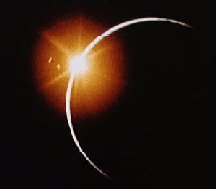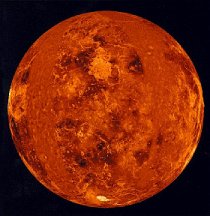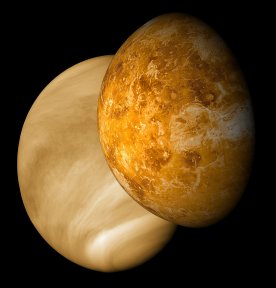
Official Edgar Rice Burroughs Tribute Site Since 1996 ~ Over 10,000 Webpages in Archive Presents Volume 1496 INSIDE AMTOR
|

Official Edgar Rice Burroughs Tribute Site Since 1996 ~ Over 10,000 Webpages in Archive Presents Volume 1496 INSIDE AMTOR
|



INSIDE AMTOR
Introduction Having written extensively about Burroughs hollow worlds of Va-nah and Pellucidar, and having extended these thoughts to speculate extensively on a hypothetical inner world of Barsoom, unrealized by Burroughs, I am forced by circumstance and the need for completion, to continue my speculations as to the nature of an inner world for Amtor. This exercise is not likely to be as rewarding as the speculations on Barsoom. Mars has quite interesting and volatile geography which can be applied in interesting ways to an interior world. Venus is a different cup of tea. I will not bore the reader with discussions of the physics and mechanics of hollow worlds and hidden suns in the Burroughs universe. I will assume that if the reader is here, they have already read the much more rewarding works on Pellucidar, Va-Nah and Beneath Barsoom and are motivated as I am, by an urge to completion. Accordingly, I trust that the reader is familiar with many ideas that I have already repeated too often. In hopes of leavening this dry loaf, I will also add some speculations as to Burroughs take on Mercury, and ways he might have used it.
Starting with the Outer Venus Venus, is quite different from Earth in the stability of its surface. Venus lacks plate tectonics, its ‘land masses’ are static and do not move. It's not clear why this is. Perhaps Venus has simply cooled faster than Earth and its geology is more quiescent. Perhaps Earth's continued geological heat and activity are the products of the collision which produced the moon. Or perhaps the moon's own tidal effects are keeping the Earth's geological pot boiling. The current theory, however, is that Venus crust is much thicker than Earth's. Although Venus is still relatively hot, geologically, its heat is not sufficient to reach through the thick crust and so the geology and geography is stable and immobile. The planet's internal heat, with no place else to go, simply builds up over hundreds of millions of years, until it is sufficient to literally melt the entire crust and reform the surface. This happened about 900 million years ago. There is no crater or surface feature on Venus older than 900 million years. One consequence of this is that Venus surface was essentially boiled, vaporized and sterilized. Any possible oceans Venus might have been evolving was simply evaporated away. The planet's atmosphere filled with toxic gases, the greenhouse effect kicked in, and the Venus of our universe was born. It is a world devoid of any possibility of life.
The Inner Venus So, assuming that Venus is like the Earth/Pellucidar and Luna/Va-Nah, what does this history pose for Venus’ interior world? We should assume that the outer characteristics of a world are about the same as for the inner world. On either side, the gravity remains the same. The same geological processes are at work. In the case of Earth, this means that we assume, and have evidence that, the interior Pellucidar has plate tectonics. In the case of the moon, we assume that the interior surface is geologically dead. For Venus, we must assume that the interior crust is as thick as the outer crust. Plate tectonics do not exist on Venus and therefore Hoos or holes between the inner and outer surfaces do not form, not temporarily or permanently. The only holes are likely permanent openings at the poles, assuming that these exist (it is likely, centrifugal rotation would have produced them). But there is more to it, with the thick crust and without plate tectonics, the interior surface of Venus is likely as stable and unchanging as the exterior surface and goes through the same processes. In particular, because internal heat has no place to go, the inner crust melts as well. This almost certainly happened nine hundred million years ago. Because we think that inner heat may tend to build up towards the centre or inner level more quickly, it is even possible that the inner surface has melted or is more prone to melting and slower to disperse heat. So, the last melting may have been a half billion or even a few hundred million years ago. This would produce a much younger and proportionately more barren and uninhabitable interior. Being slower to disperse heat on the inside has an effect on the geology. Venus’ surface has less diversity in elevation than either Mars or the Earth. Venus surface is fairly uniform, the lowlands are not very low, the highlands are not very high. In short, its probably very flat, broken only by Volcanoes and Volcanic shield areas. Other worlds have much greater differences in elevation, both inside and outside. This is, in part a consequence of the crust melting, and the lack of plate tectonics or major impacts which might reshape the surface. Earth's plate tectonics, for instance, has the continents bouncing all over the place over billions of years, shaping and reshaping mountains, carving out valleys and canyons, erasing craters, creating islands and doing all sorts of interesting things. Mars geography was shaped by titanic asteroid impacts which deformed the planet. Venus is different. Now, if the interior is slower to disperse heat, then that means that the surface remains molten and plastic for longer before cooling, and even the modest elevations in Venus surface are evened out further. So, there won't be much in the way of mountains and highlands, valleys and lowlands on the inner Venus. It will be mostly flat plains. Ho hum. Unlike Mars, where we can track the titanic impacts effects on the inner world, or Earth where we can speculate about the interactions of continental plates inside and outside, there isn't really anything that will shape Venus internal geography. There's no sign of a Hellas level impact on the surface that would shape the internal geography. At best, we can fall back on centrifugal force and assume that the shallow seas and oceans will girdle the equator of the inner world and that the highlands will be towards the poles. This is roughly a reversal of Venus’ exterior. Like Earth's Pellucidar, Venus’ interior world, or Amtor's, will have a sun or star. And on its face, because Venus is roughly the size and mass of Earth, we might assume that this sun or star will probably be roughly as energetic as Earth's. That is, it will provide heat and light similar to the external sun. There may be one interesting wrinkle. Our Venus has a super-thick atmosphere, Amtor does not. Perhaps one reason for the difference is the hollow world structure and Amtor's internal sun. In this situation, the gravity of the dwarf black hole at the centre of Amtor's internal sun would tend to wrap the heavy elements of the atmosphere around it in an internal sphere. This would mean that instead of being a bright yellow globe in the centre of the sky, Venus internal sun would be a huge, roiling, sputtering softly glowing sphere taking up an appreciable chunk of the sky. That would be fairly impressive visually. Other aspects of the inner world would be prosaic. The atmosphere of the inner world, connected at the poles, would be about the same as the outer Amtor. The inner world would have water, which would flow in through the polar openings. However, Earth's Pellucidar sports additional openings from time to time. So its likely that the flow of water into Pellucidar is greater than Amtor. Approximately 30 to 50% of Pellucidar’s surface is water covered. Amtor's outer surface seems to have less water than Earth. So arguably, as little as 10 to 30% of Amtor's inner world is water covered. Which implies that its mostly dry or desert. Or perhaps it has large seas that are extremely shallow. But shallow seas evaporate quickly, so you'd get a lot more moisture content in the atmosphere, which would fall back fairly steadily as an endless soft rain. This doesn't seem any more enticing than a desert interior. Of course, this assumes that Venus has at least openings at the poles. Given the thickness of the crust formation, its possible that it does not. If it doesn't, then there will be no exchange of atmosphere or seepage of water into the interior. In which case the internal atmosphere may be different and the inner world may be a dry hot, endless desert. There would be no channel by which surface life could invade the interior, and thus quite possibly no internal life of any sort. Of course, there might well have been a transformation of the interior by terrestrial means, but then this would mean that while the interior environment might have a habitable environment and life, it would be so distinct from the outer world that it might as well be on the other side of the universe, and therefore not really something that we could discuss coherently.
Life on the Inside Track Amtorian life would migrate from the surface to the interior. However, Earth's opening and closing Hoos means that Earth life from all continents and era's wind up preserved in Pellucidar. Amtor lacks Hoos, its openings are only at the poles. This means that only the life forms that inhabit the polar and sub-polar regions will colonize the interior. There will be some adaptation and evolution to adjust to endless open areas and warmer climate, but not all that much. Within Amtor's inner world, the stable climate, placid seas and rolling plains will slow evolution to a crawl and facilitate a very limited, and not very robust assortment of Flora and Fauna. This is not the sort of interior that would spur the development of intelligent species. Even if life was seeded within Amtor from Earth in the same transmutation process that seeded the exterior, then the interior's uniform conditions would probably result in the interior being dominated by a handful of fairly placid and not terribly adaptable or robust species. Finally, we would expect that humans would find their way into the interior of Amtor. There's no indication that they've done so yet. The Amtor culture believes that the poles are at the edges of the world and simply don't go there. The interior may be unoccupied. On the other hand, the likelihood is that even if Amtorians did find their way in to colonize the interior, they would simply reproduce an even less diverse sub-set of the Amtor culture which seems to dominate the planet. The interior civilization would find an interior world of endless days, a huge sputtering sun overhead, featureless geography, a narrow selection of animals and plants and either endless deserts with only limited fertile areas, or flat plains and shallow seas with endless drizzle. Well, it might possibly be a nice place to live. But I wouldn't want to have an adventure there.
A Brief Exploration of Rasoom
Thavas also identifies intelligent life on Venus, but not on the Moon. This suggests that the Barsoomians instruments cannot penetrate planet's interiors. They may not even be aware that planetary interiors like Pellucidar or Va-nah may be inhabited. Which means that when Ras Thavas refers to intelligent life being on Mercury, he is referring to the surface, and not to an interior. Considering what was known of Mercury, even in Burroughs day, that's a hell of a trick. Only thirty-six million miles from the sun, Mercury orbits in a mere 88 days. In Burroughs day, it was believed that Mercury's rotation and revolution were equal, so that like the Moon to Earth, Mercury always had one face to the sun and the other face in eternal darkness. Permanently the hottest spot in the solar system on the one side, and frozen solid on the other. We know now that Mercury's rotation is 59 days, so that it turns slowly, baking and freezing the entire surface over hundreds of days. But I think in this case, we'll accept Burroughs understanding. Mercury was a small world, only half again as large as the Moon at 3100 miles diameter, and by every account, airless and uninhabitable. The consensus of scientists in Burroughs day was that it was a sterile, airless, cratered moonlike world. From the pictures that we have of Mercury, they were right. The only substantial difference between the Moon's surface and Mercury's is that Mercury lacks the large lunar maria. It's simply nothing but craters and rock. Mercury's density is greater than that of either the Moon or Mars, therefore its gravity is almost that of Mars. Burroughs faced a similarly unappealing world in the Moon, and was able to figure out how to imbue it with life and civilization, although he had to go all Pellucidar to do it. But with Mercury, he has inadvertently shut that option away. The interior of Mercury may be inhabited, or it may not be. But the surface, somehow, is. It's possible that Ras Thavas was not referring to human life, it certainly defies reason to believe in human life and suggest that some form of inhuman or machine life was what was referred to by Thavas. But human life has been found on every significant body, even ones as unlikely as Thuria and Jupiter. So, if pushed, Burroughs would have probably found a place to put humans. In Burroughs time, the only remotely habitable area of Mercury lay in the permanent twilight zones between light and dark sides. It's likely here that Burroughs would have put his human civilization. Perhaps it would have occupied domes or underground refuges like Okar in Warlord of Mars and Pankar in Llana of Gathol on Barsoom. Or perhaps they would have occupied deep sheltered valleys where the air was thicker, as he seemed to speculate at points when Julian watched the Moon in the Moon Maid. Or conceivably, he saw the twilight zone as a place of storms, constantly torn between the sunside's heat and the darkside's cold. We will never know. As to the possible interior world for Mercury that is implied by the existence of Pellucidar and Va-nah, it is likely that this too would be disappointing. It is likely that Mercury's inner world follows the pattern set by Va-nah, a geologically dead world covered by permanent hoos which provide light and heat. Mercury is small enough that it would cool relatively quickly. As on Va-nah, holes or vortexes connecting the inner and outer world would freeze in place, and the surface of Mercury would be dotted by Hoos. Unlike Va-Nah, Mercury lacks the confluence of tidal gravities that might make for an electrically charged piezo-electric interior. Like Va-Nah it also probably lacks an active sun in the centre, its dwarf black hole, due to its size, is likely contained in an inert shell of dense matter. Because in Burroughs universe, Mercury is locked with one face forever towards the sun, it is likely that the sunlit Hoos are permanent features, permanent blast furnaces sterilizing the territory that they strike, and stirring the atmosphere to great vortexes and storms. In Escape on Venus, Carson encountered a ferocious storm when a ‘Hoos’-like gap in the clouds allowed the sun to penetrate directly to the surface. The interior of Mercury is probably a world of permanent fierce storms, although its likely that the storms are are confined to local areas. The Hoos stormlands supply Mercury with its light and heat and keep the atmosphere circulating. There is no equivalent to Hellas or Argye strikes on Mercury, so the radical changes made in inner and outer surface would not be found. At best, Mercury has been hit hard enough to produce disordered ‘strange territory’ on the opposite sides of strikes. This would have probably affected the inside world disrupting the inner crust, causing fragments to ricochet about peppering the interior with craters (though not as many as on the surface), and creating strange territory under and opposite the impact site. Mercury is geologically dead, so you wouldn't get active volcanoes. There isn't much more we could guess about the interior of Mercury. A few spots of strange territory, craters, permanent storms, perhaps some water seeping in from comet impacts on the surface, and probably an inner atmosphere. The interior area of Mercury is probably around 15 to 20 million square miles. Substantially more than Va-Nah and enough to support a lively civilization and ecosystem. This is so great compared to the mere sliver of a few million square miles in the twilight zones, that it is likely that any surface habitation in those zones are merely colonies from the inner world Hoos in the twilight zones would probably be the means that the Mercury civilization could emerge onto the surface There would also be Hoos on the dark side, but apart from some discharge of heat, its unlikely that the frozen dead dark side would be of much interest. It's possible that strange intelligent and animal life might cling to the wells of heat produced by the Hoos here. The Hoos areas would be frozen of course, but not as cryogenically cold as the rest of the dark side. The interior Mercurians might travel to the dark side for observatories, science or simply mining. We could imagine that the civilization of the Mercurians would be at quite a high level. Their world is diverse and volatile, and they have access to both the outer and inner surfaces. This richness of environment might suggest either a scientifically progressive civilization, or a radically deranged superstition laden land. As to how life and humanity wind up there, I would suggest, once again, a mechanism of planetary transformation, as discussed in “Are Barsoomians Human.” As to the nature or quality of that life, or of human life, I would hesitate to discuss. The lighter gravity, thick internal atmosphere and volatile storms suggest perhaps, that aerial life might have an advantage. The sole recommendation for human life is that Ras Thavas had some hopes for it.
Other Inner Worlds The outer solar system contains a handful of bodies as large or larger than Earth's Moon, which could conceivably support inner worlds with life and humanity within them. They are, respectively:
But having said that, the prospects for these inner worlds seem dim. All of them probably resemble Va-Nah and have inert dwarf black holes wrapped in stable shells, and so they do not possess internal suns. They are too far for heat from the sun. Their best hopes of energy to sustain internal human life would be tidal forces from their principal worlds. A good bet with the satellites of Jupiter and even Saturn, a poor bet with the satellite of Neptune, and a very bad bet for Pluto. We know too little about these small distant worlds to even speculate as to their geography and geology, save only that one Jovian satellite may be nothing but a world ocean down to its core and covered with ice. In the end, this lack of knowledge prevents us from really coming up with anything interesting. They are blank slates. Still, Burroughs universe finds inhabited worlds in the solar system,
on places as small as Thuria and as vast as Jupiter. So the
rules that we have taken from the hollow worlds of Earth and the Moon,
and which we've applied ever less profitably to Mars, Venus and then Mercury
should not be considered determinative of the limits of human life.
|







ERBzine WEB REFS
|
for Den Valdron's Fantasy Worlds of ERB |
![]()

![]()
![]()

![]()
BILL
HILLMAN
Visit
our thousands of other sites at:
BILL
AND SUE-ON HILLMAN ECLECTIC STUDIO
ERB
Text, ERB Images and Tarzan® are ©Edgar Rice Burroughs, Inc.-
All Rights Reserved.
All
Original Work ©1996-2005/2010 by Bill Hillman and/or Contributing
Authors/Owners
No
part of this web site may be reproduced without permission from the respective
owners.